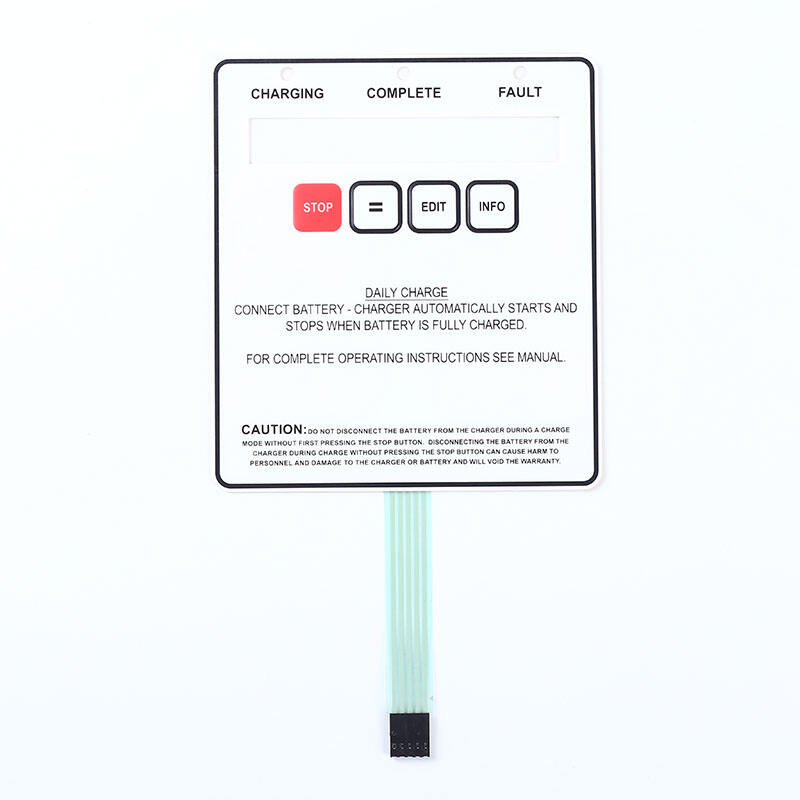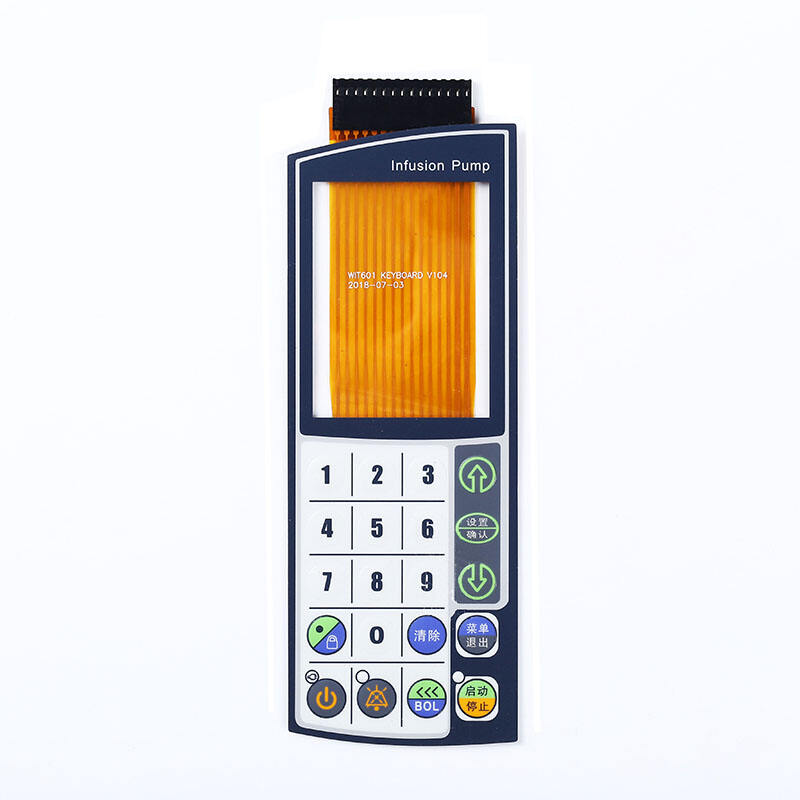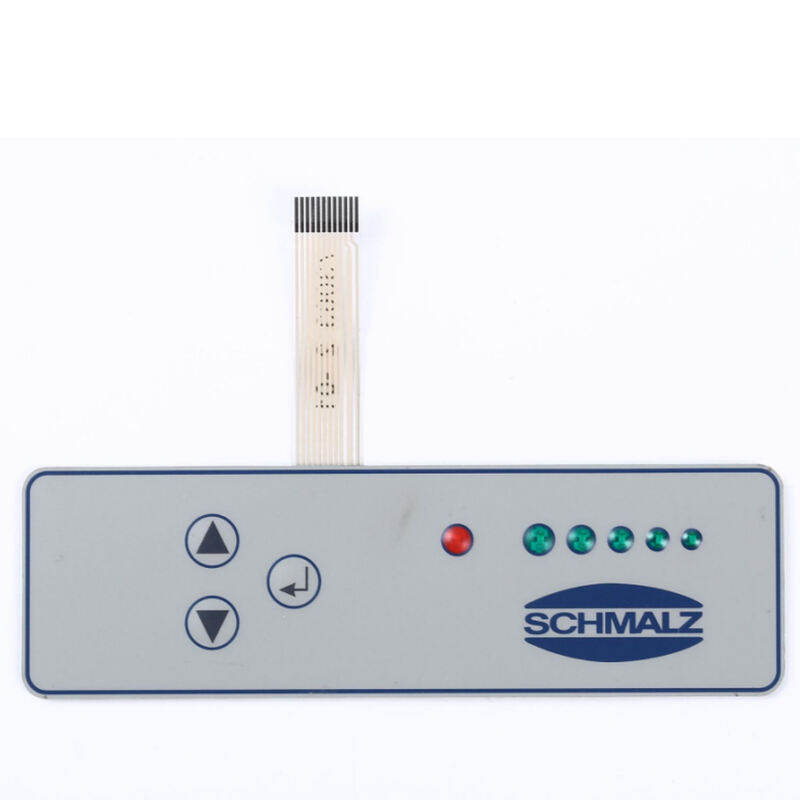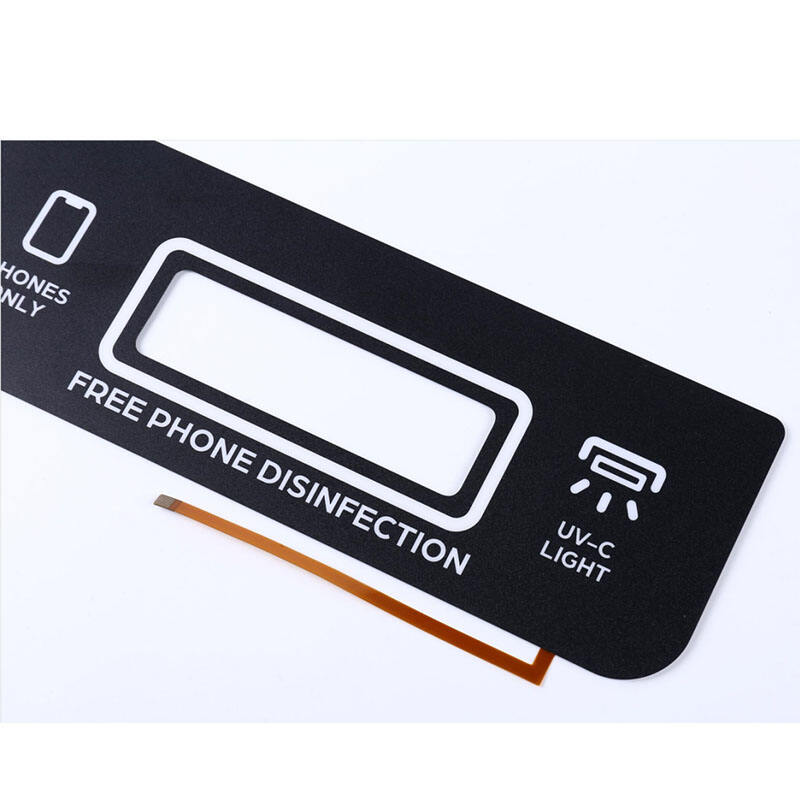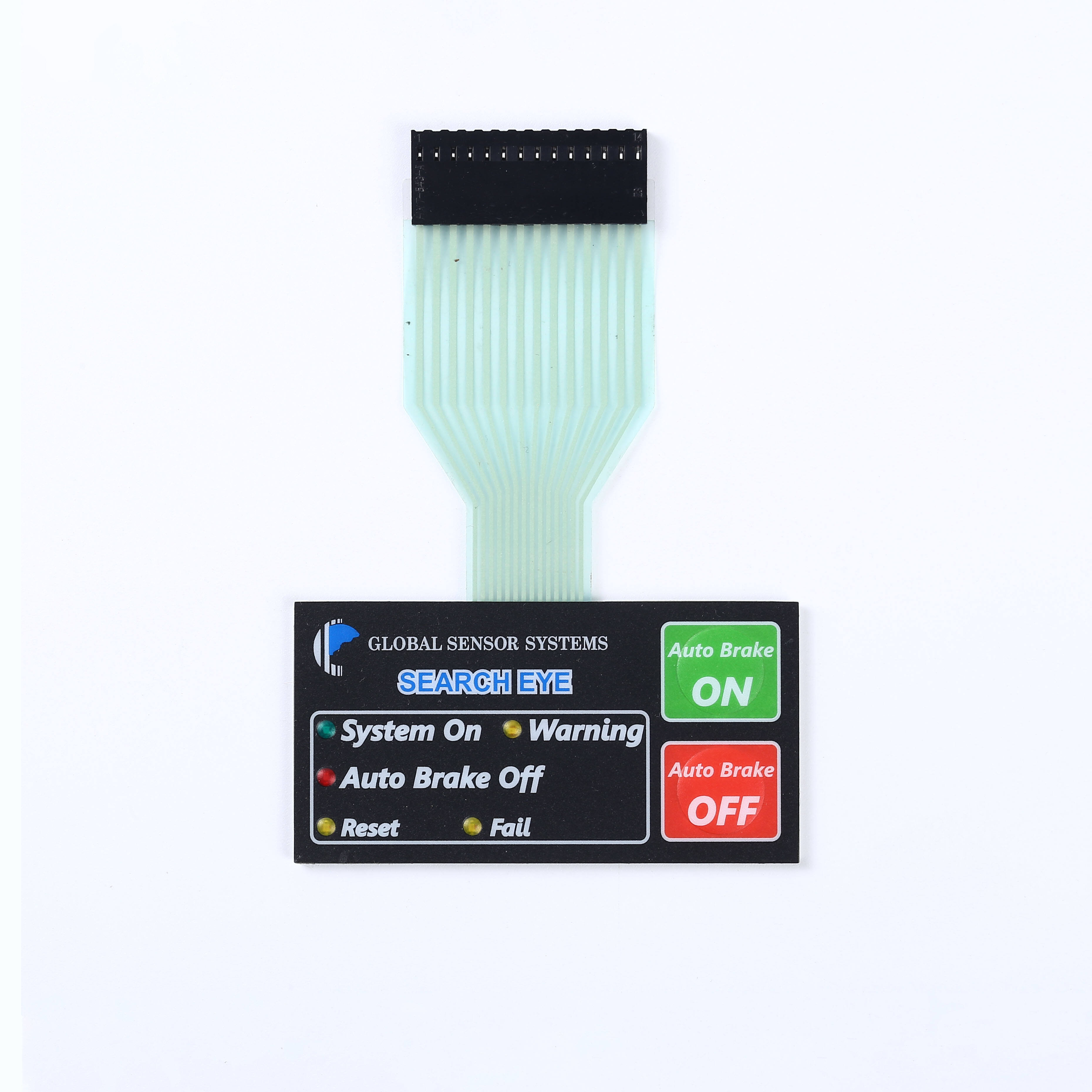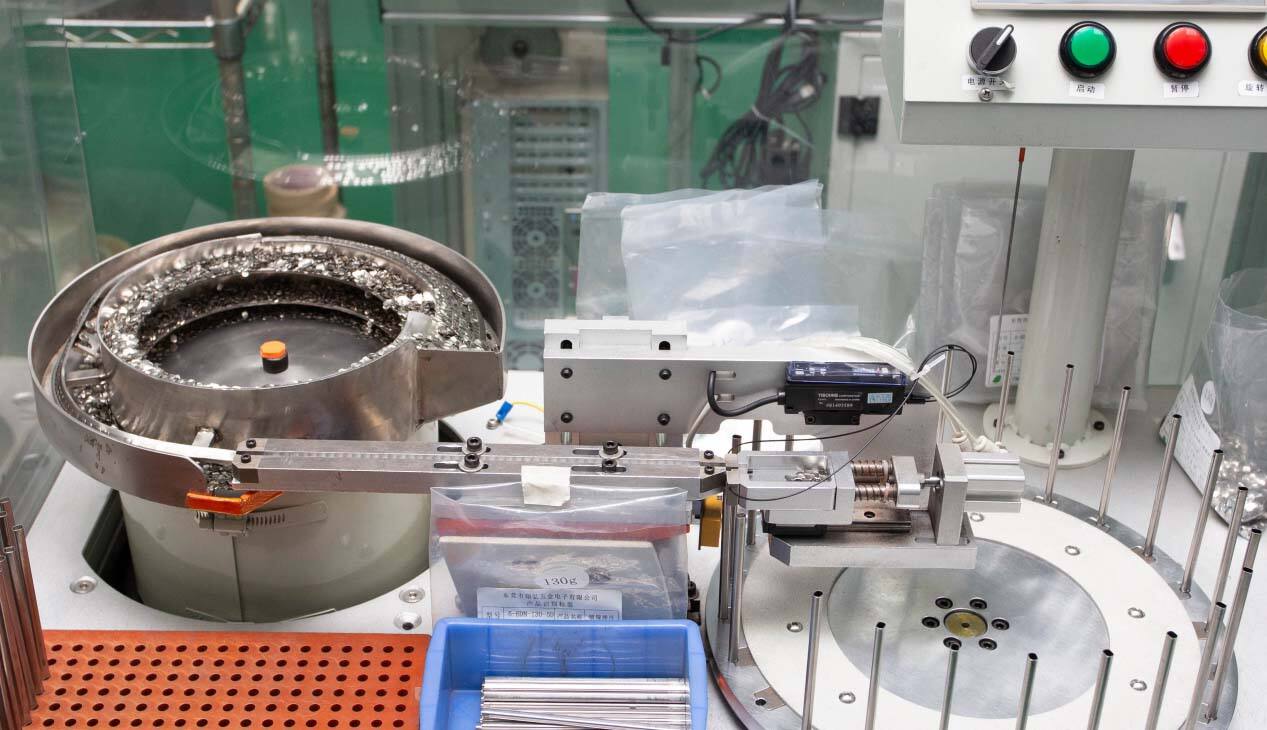Sollten Sie auf einen Budget- oder High-End-Membranschalter setzen? Lassen Sie uns darüber sprechen.
Wesentliche Unterschiede im Aufbau von Membranschaltern
## Materialqualität und Haltbarkeit
Der Aufbau eines Membranschalters hängt stark von den verwendeten Materialien ab, darunter Polyester (PET) und Polycarbonat (PC). Polyester zeichnet sich durch seine Flexibilität und Chemikalienbeständigkeit aus und verleiht den Schaltern oft eine überlegene Haltbarkeit, was sie in Anwendungen zuverlässiger macht, die taktilen Feedback erfordern. Andererseits wird Polycarbonat für industrielle Zwecke bevorzugt, da es flammenhemmende Eigenschaften und Schleifbeständigkeit aufweist. Es ist außerdem wirtschaftlicher und einfacher zu verarbeiten. Die Wahl der Materialien beeinflusst direkt die Lebensdauer und Widerstandsfähigkeit der Schalter, wie Hersteller betonen. Darüber hinaus prägen zunehmend Umweltbedenken die Kundenpräferenzen und drängen Hersteller dazu, nachhaltige und recycelbare Materialien zu verwenden, die den Marktforederungen nach umweltfreundlichen Lösungen gerecht werden.
Mechanismen für taktile Rückmeldung
Taktiler Feedback ist ein kritischer Faktor in der Benutzererfahrung, wobei Optionen wie erhöhte Tasten oder Soft-Touch die Benutzbarkeit erheblich verbessern. Diese Funktion stellt sicher, dass Benutzer eine spürbare Reaktion erhalten, wenn sie den Schalter aktivieren. Ihre Bedeutung wird durch Studien unterstrichen, die zeigen, dass effektiver taktiler Feedback die Benutzersatisfaction und Präzision verbessern kann, was es für Anwendungen wie industrielle Maschinen und Verbraucherelektronik, bei denen Zuverlässigkeit und Genauigkeit von entscheidender Bedeutung sind, unerlässlich macht. Statistische Daten bestätigen, dass die Mehrheit der Benutzer Geräte vorzieht, die deutliche taktile Signale bieten, was die Notwendigkeit vielfältiger Feedback-Mechanismen in verschiedenen Anwendungen bestätigt.
Grafische Überlagerungen und Anpassungsoptionen
Grafische Overlays in Membranschaltern dienen nicht nur der Ästhetik; sie spielen eine wichtige Rolle bei der Markenbildung und Funktionalität. Durch umfangreiche Anpassungsoptionen können Unternehmen diese Overlays an ihre Markenidentität anpassen, was die Benutzerinteraktion verbessert. Die Anpassungsfähigkeit fördert die wettbewerbsfähige Differenzierung, wobei Unternehmen wie Butler Technologies Inc. erfolgreich maßgeschneiderte Grafiken nutzen, um sich auf ihrem Markt hervorzutun. Diese individuellen Overlays können komplexe Logos, Farben und sogar Oberflächenstrukturen integrieren, die sich mit den visuellen und funktionalen Anforderungen einer Marke decken, was zeigt, wie Anpassung die Markenpräsenz und Kundenbindung erheblich stärken kann.
Leistungsvergleich: Budgetmodelle im Vergleich zu High-End-Modellen
Umgebungsresistenz und IP-Schutzarten
Widerstandsfähigkeit gegenüber Umwelteinflüssen ist ein entscheidender Faktor bei der Auswahl von Membranschaltern, da sie die Leistungsfähigkeit des Schalters in rauen Bedingungen bestimmt. IP-Bewertungen (Ingress Protection) geben Aufschluss über die Widerstandsfähigkeit eines Schalters gegen Staub und Wasser. Hochwertige Modelle verfügen im Allgemeinen über höhere IP-Bewertungen, wie z.B. IP67, was bedeutet, dass sie vollständig vor Staub geschützt sind und eine Wasserimmersion bis zu einer bestimmten Tiefe aushalten können. Budgetmodelle könnten niedrigere Bewertungen wie IP54 haben, die einen Schutz vor begrenztem Staubeingang und Wasser spritzen bieten. Zum Beispiel hat eine Studie im Journal of Electronic Materials hervorgehoben, dass Schalter mit höheren IP-Bewertungen tendenziell länger in staubigen und feuchten Umgebungen halten. Das Verständnis dieser Bewertungen hilft Benutzern sicherzustellen, dass sie einen passenden Schalter für ihre spezifischen Umweltherausforderungen auswählen.
Lebensdauer und Betätigungszyklen
Die Lebensdauer und die Tastenanschlagszyklen von Membrantastaturen haben erhebliche Auswirkungen auf die langfristigen Kosten und den Gebrauch. Hochwertige Membranmodelle sind darauf ausgelegt, über 5 Millionen Tastenanschlagszyklen zu überstehen, was ihre Verwendbarkeit im Vergleich zu Budget-Optionen, die normalerweise etwa 1 Million Zyklen aushalten, erheblich verlängert. Diese Robustheit hängt direkt mit der Austauschfrequenz zusammen; Premium-Modelle verringern das Bedürfnis nach häufigen Wechseln und minimieren so sowohl Downtime als auch Kosten im Laufe der Zeit. Zum Beispiel bieten Hersteller wie Butler Technologies Garantien an, die die längeren Lebensdauern ihrer Schalter widerspiegeln und Unternehmen Sicherheit in ihrer Investition geben.
Signalgenauigkeit und EMI-Abschirmung
Die Signalausrichtung ist von entscheidender Bedeutung, insbesondere in sensitiven Anwendungen, wo präzise Eingaben entscheidend sind. Hochwertige Membranschalter integrieren oft fortgeschrittene EMI (Elektromagnetische Störungen) Abschirmung, um die Signalintegrität in störanfälligen Umgebungen zu gewährleisten. Diese Funktion ist für Anwendungen in der Medizin- oder Luftfahrtindustrie essenziell, wo Signalstörungen ernsthafte Konsequenzen haben können. Zum Beispiel zeigen Tests durch die EMC Compliance Laboratories, dass Premiummodelle mit EMI-Abschirmung bis zu 40 % besser in der Aufrechterhaltung der Signalausrichtung abschneiden im Vergleich zu günstigeren Modellen ohne solchen Schutz. Dies unterstreicht die Notwendigkeit, in hochwertige Schalter zu investieren, für Umgebungen, die anfällig für erhebliche elektromagnetische Störungen sind.
Anwendungsbezogene Empfehlungen
Industrielle Steuerungsbedienfelder und Membrantastaturen
Membranschalter sind für industrielle Umgebungen hochgradig geeignet, hauptsächlich aufgrund ihrer Zuverlässigkeit und Sicherheitsfunktionen. Sie werden insbesondere für ihre Widerstandsfähigkeit gegen schwierige Bedingungen geschätzt, einschließlich Belastung durch Staub und Feuchtigkeit, was für industrielle Anwendungen essenziell ist. Zudem sind Membrantastaturen, eine Form dieser Schalter, einfach zu reinigen und bieten Eindringlingsschutz, was sie ideal für die Einhaltung von Hygiene und Betriebswirksamkeit in Fabriken oder Produktionslinien macht. Der Markt wächst weiter, wie prognostiziert durch die erwartete Erweiterung auf 12,4 Milliarden USD bis 2031, angetrieben von einer robusten Nachfrage nach industriellen Steuerungsbedienfeldern, die Membrantastentechnologie integrieren.
Anforderungen an Medizinprodukte
Der medizinische Sektor hat präzise Anforderungen an Membranschalter, mit Fokus auf Aspekte wie Hygiene, Dauerhaftigkeit und Einhaltung regulatorischer Standards. In medizinischen Umgebungen, wo Sauberkeit von höchster Priorität ist, sind diese Schalter wegen ihrer leichten Reinigung und Widerstandsfähigkeit gegen Verunreinigungen hervorragend geeignet. Sie werden häufig in Krankenhausausrüstung eingesetzt, von Handgeräten bis hin zu komplexen Überwachungssystemen. Regulatorische Standards, wie zum Beispiel solche zur Sicherstellung der Ausschließung gefährlicher Stoffe (RoHS), leiten ihre Verwendung in medizinischen Anwendungen. Diese Faktoren unterstreichen die Bedeutung von Membranschaltern, da sie eine dauerhafte und konforme Schnittstelle in klinischen Einrichtungen bieten, wodurch sichere und effektive medizinische Vorgänge ermöglicht werden.
Verwendungsfälle von Verbraucherelektronik
In der Unterhaltungselektronik werden Membranschalter aufgrund ihrer Benutzerfreundlichkeit und ästhetischen Anziehungskraft weit verbreitet. Sie sind häufig in Geräte wie Fernbedienungen, Spielekonsolen und Küchengeräte integriert, um eine nahtlose Benutzererfahrung zu bieten. Die Attraktivität liegt in der Vielseitigkeit des Designs, der die Möglichkeit bietet, die Geräte individuell zu überlagern, um ihr Aussehen zu verbessern. Darüber hinaus zeigt sich, daß die Verbraucher zunehmend schlanke und funktionelle Schnittstellen bevorzugen, die durch Membranschalter sehr gut erfüllt werden. Marktforschungsergebnisse zeigen einen stetigen Anstieg von Smart Home-Geräten und persönlicher Elektronik, was die Einführung dieser Schnittstellen aufgrund ihrer Kosteneffizienz und Anpassungsfähigkeit in verschiedenen elektronischen Produkten ankurbelt.
Produktvitrine: Membranschalterlösungen
Schalter für die Membran
PET-Folien-Taster bieten bemerkenswerte Vorteile wie Transparenz und Flexibilität, wodurch sie eine beliebte Wahl für viele Anwendungen sind. Ihre Klarheit ermöglicht eine präzise Sichtbarkeit, während ihre flexible Natur die Integration in verschiedene Geräte-Designs erleichtert, was die Benutzerinteraktion verbessert. Diese Taster funktionieren normalerweise gut in Umgebungen, die eine anpassungsfähige Operation erfordern, und können auf spezifische Leistungsmerkmale zugeschnitten werden.
Medizinische Behandlung FPC-Membranwechsel
Flexible Druckschaltkreise (FPC) sind unverzichtbar für medizinische Anwendungen aufgrund ihrer Anpassungsfähigkeit und Einhaltung strenger Standards. Die Bedeutung von FPC in medizinischen Bereichen kann nicht genug betont werden; sie gewährleisten einen reibungslosen Betrieb und sind anpassbar, um spezifischen Anforderungen zu entsprechen, während sie den notwendigen medizinischen Standards gerecht werden, was Zuverlässigkeit und Haltbarkeit in der Gesundheitsversorgung sicherstellt.
Led-Membran-Schalter
Die Integration von LED-Rücklichtern in Membranschalter erhöht ihre Sichtbarkeit erheblich, was in Umgebungen mit gedimmtem Licht entscheidend ist. Diese Funktion verbessert die Fähigkeit der Benutzer, Steuerelemente zu sehen und zu bedienen, wodurch sie ideal für Situationen sind, in denen visuelle Indikatoren von großer Bedeutung sind. Anwendungen reichen von Industrieinstrumenten, die bei schwachem Licht funktionieren, bis hin zu Notfallmedizingeräten, die eine schnelle Lesbarkeit erfordern.
Individuell rückseitig beleuchteter Membranschalter
Maßgeschneiderte, rückseitig beleuchtete Membranschalter bieten sowohl optische als auch funktionelle Verbesserungen durch einzigartige Beleuchtungskonfigurationen. Marken, die diese Schalter effektiv einsetzen, profitieren von einer verbesserten Produktunterscheidung und einer optimierten Benutzerinteraktion. Sie sind bemerkenswert in Branchen, die auf maßgeschneiderte Lösungen setzen, die Benutzeranziehung mit überlegener Funktionalität des Bedienfelds verbinden.
Haltbarer PCB-Unterstützter Membranschalter
PCB-unterstützte Membranschalter werden wegen ihrer Robustheit gelobt, was sie für anspruchsvolle Umgebungen geeignet macht. Diese Art der Konstruktion gewährleistet hohe Leistungsniveaus und eine verlängerte Lebensdauer, was für Anwendungen entscheidend ist, die dauerhafte Schnittstellen benötigen. Die durch die PCB-Integration gebotene strukturelle Stabilität unterstützt zuverlässige Schaltkreise und hält selbst unter harten Bedingungen stand, ideal für industrielle und spezialisierte wissenschaftliche Geräte.
Kosten-Nutzen-Analyse für Entscheider
Anfangsinvestition im Vergleich zur Langzeitzuverlässigkeit
Beim Vergleich der anfänglichen Investition mit der Langzeitzuverlässigkeit sollten Entscheidungsträger die Qualität des Produkts und deren Auswirkung auf Einsparungen im Laufe der Zeit berücksichtigen. Hochwertige Membranschalter bieten Haltbarkeit und verringern Wartungskosten durch weniger Ausfälle und Ersatzteile. Obwohl Premiumoptionen zunächst teuer erscheinen können, führen sie zu einem erheblichen ROI, indem sie Downtime minimieren und eine konsistente Leistung sicherstellen. Eine Investition in qualitativ hochwertige Produkte ist insbesondere in Sektoren von Vorteil, in denen eine ununterbrochene Betriebsführung entscheidend ist, wie im Gesundheitswesen und in industriellen Anwendungen.
Industriezertifizierungskosten (UL, RoHS)
Das Verständnis der mit Branchenzertifizierungen wie UL und RoHS verbundenen Kosten kann Einblicke in sowohl Ausgaben als auch Vorteile für ein Unternehmen geben. Der Zertifizierungsprozess umfasst eine eingehende Bewertung und Prüfung, um die Einhaltung von Sicherheits- und Umweltstandards sicherzustellen, was die Produktentwicklungs kosten erhöhen kann. Dennoch stärkt die Erhaltung dieser Zertifikate das Kundenvertrauen und verbessert den Unternehmensruhm, was für Firmen, die sich auf wettbewerbsintensiven Märkten etablieren möchten, entscheidend ist. Zertifizierung unterstreicht nicht nur die Engagement gegenüber Sicherheit und Umweltpraktiken, sondern hebt Produkte auch auf dem Markt hervor.
Wann Premium-Funktionen priorisiert werden sollten
Die Investition in Premium-Funktionen wird in Szenarien, in denen verbesserte Funktionalität und Benutzererfahrung von größter Bedeutung sind, notwendig. Zum Beispiel profitieren Membranschalter in medizinischen Geräten von der Einbeziehung von taktilem Feedback und hoher Sichtbarkeit aufgrund ihrer häufigen Verwendung bei kritischen Operationen. Während Premiumversionen höhere Kosten haben, bieten sie oft langfristige Vorteile wie verbesserte Leistung, erhöhte Benutzerzufriedenheit und geringere Verbesserung. Die Priorisierung dieser Merkmale stellt sicher, dass die Produkte spezifischen Betriebsanforderungen entsprechen und somit zu einem optimalen Produktlebenszyklus und einer optimalen Nutzerbindung beitragen.
Top-Nachrichten
-
Anweisungen für die Probenahme der Membranschalterplatte
2023-12-14
-
Kennst du die Gründe, warum heiße Scheiben nicht aufspringen, wenn sie gepresst werden?
2023-12-14
-
Was ist ein Lichtführer? Hongmao ist spezialisiert auf die Herstellung von Lichtführerblättern, wussten Sie das?
2023-12-14
-
Wie viele Regler sind nötig, um einen Membranwechsel zu machen?
2023-12-14

 EN
EN
 AR
AR
 FR
FR
 DE
DE
 IT
IT
 JA
JA
 KO
KO
 PT
PT
 RU
RU
 ES
ES
 VI
VI

